Teeth Whitening: The Definitive Guide
Introduction
Are you concerned about your pearly whites not being so pearly anymore?
Maybe that your gleaming smile belongs to days long gone?
If so, then you are not alone.
The American Association of Orthodontists did a survey in 2013. They found that nearly 90% of the interviewed doctors (sample of 1200) had such a request from some of their patients.
The need for a better smile explains why teeth whitening is so popular.
But it is not the only reason.
It is also one of the least invasive procedures in cosmetic dentistry.
Now referring to teeth whitening as “one of the least …” is a bit simplistic.
Why?
Because, it comprises several different approaches, so it is not just one well-defined procedure.
And maybe that you have come here because you are confused by the numerous methods proposed.
Or you simply need more information in order to choose the best approach for yourself.
Whatever the reason, you have come to the right place.
Our team of dentists with over 175 years of cumulative dental experience has written this guide.
It is a promise … We will try to cover all the methods available.
In other words, we will not limit ourselves to describe the teeth whitening strategies that we offer at Sutton Place Dental.
Instead, we will try to provide an unbiased assessment of all the existing approaches.
And we will use published literature as much as possible during this process.
So, what more can we say (?) other than … enjoy!s place while your caring dentist ensures that all those pesky coffee, tea, and foods stains have disappeared.
Teeth whitening methods
What is teeth whitening?
In short, the goal of teeth whitening procedures is to reduce or remove surface stains from your teeth.
You can have varying degrees of whitening, for instance, you can:
- restore the original tooth shade
- or whiten your teeth beyond the original tooth color.
And if you have guessed that the different shades of white may have some relation to the type of approaches used, … that is correct.
But the duration of a procedure, or the number of times one repeats it, is also significant.
Likewise, the types of stains play a role too.
I have mentioned “teeth whitening procedures” … so how many are there?
Many, but you can group them into three broad types of products/methods which are commonly used.
Let’s look at them!
A brief summary of the teeth whitening methods
Since we are dentists, we will start with…. well, with what is used at a dental office (see also Chapter 1: In-office teeth whitening).
Your dentist will:
- Use a range of high-tech clinical equipment to achieve the desired results.
- Use high concentration of bleaching agents which will penetrate your enamel (and even dentin) deeper than the other two methods (see below).
- Provide supervision throughout the process.
What are the advantages of dental office whitening procedures?
First and foremost, they provide immediate results.
But that is not all.
The procedures are also safe, and they will not harm your tooth enamel or dentin.
In-office bleaching procedures are in fact the safest.
Given the high concentrations of bleaching agents used … Are you surprised?
Yet, there is a simple explanation.
Conditions are controlled ensuring a safe and pain-free experience.
How?
Measures are taken to protect your gums from the (bleaching) agents. These (measures) consist of a protective gel or a rubber shield placed over your gums.
OTC products do not offer this possibility.
Another family of procedures takes place in your home with products prescribed and dispensed by your dentist:
- Typically, you will be using a custom-made tray that will fit your teeth (see also How do you whiten your teeth with gels on trays?)
- You will use gels with lower concentrations of bleaching agents than those used in the office.
Finally, the last group is for those who want to decide on their own.
Does that sound like you?
If so, then read on.
To remove your teeth’s stains, you will purchase your own OTC whitening products (see also Chapter 2: Whitening strips, toothpaste, paint-on films, and trays with gels).
These include many possibilities, suiting different budgets and temperaments, but:
and results are not immediately visible.
They all use low concentrations of whitening agents.
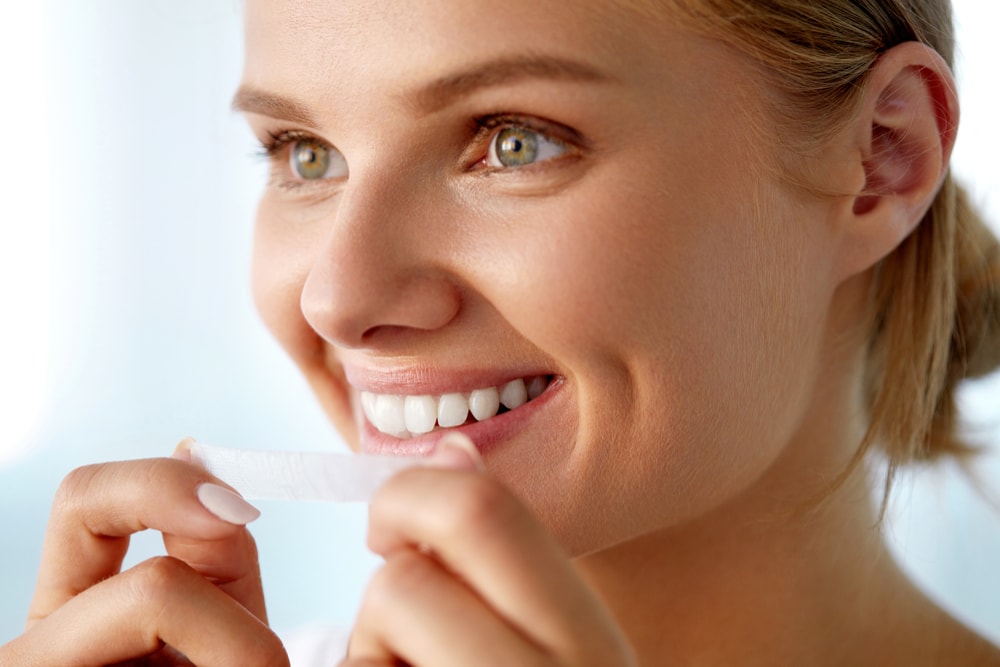
Some of the most common ones include:
- Disposable trays that hold the gel in place. These are malleable to fit your dentition. They are pre-loaded with proper amounts of whitening gels.
- Whitening strips where the gel is embedded. You will apply the plastic strip on your teeth.
- Bleaching pens.
- Toothpaste with hydrogen peroxide.
- Paint-on gels or varnishes, …
All these OTC methods are cheaper than in-office procedures.
But since OTC products use low concentrations of bleaching agents, results take some time to show.
It is also possible to use products that do not contain whitening agents. These include toothpaste with abrasives (e.g., charcoal particles).
So, this leads us on to an inevitable question…
Which is the best teeth-whitening system for me?
You might be wondering whether there is a right or wrong method (?)
Negative.
There is no wrong or right teeth whitening procedure/product … as long as your dentist supervises it.
If your teeth are sensitive and you want quick results, then you are a better candidate for in-office treatment.
An in-home treatment system is better suited if you are on a budget.
You may also want to whiten your teeth in the comfort of your own home.
And who can object to that?
Your dentist will provide you the best advice after a thorough dental examination.
The optimal solution will depend on your dental health, budget, temperament, and lifestyle.
Let’s now move on to a different but related subject.
You have had a bird’s eye view of the different teeth whitening products and methods.
But it is no secret that price is also something to consider.
So, let’s look at what costs one should expect.
How will these vary depending on the products and chosen strategy?
Next.
Costs of teeth whitening
Teeth whitening cost and insurance coverage in the USA
Money cannot buy happiness, but it can buy a perfect smile.
We have seen the different methods, products, procedures used to restore your teeth whiteness.
Here below you can find a summary of what they cost.
Prices in the market can vary significantly:
- In-office procedures cost up to $1000 but usually range between $300-$800.
- Whitening trays provided by a dental professional, differ anywhere between $300-$600.
- For OTC products prices vary widely starting:
- As low as $3-$8 for a toothpaste;
- $10-$40 for an OTC tray at the local pharmacy;
- between $40-$70 for whitening strips.
And do insurances cover teeth whitening?
Unfortunately, not.
Most health insurance options do not comprise teeth bleaching.
This is also true of most other cosmetic dentistry treatments.
But many patients use their Flex-spending programs. They are offered by their employers to pay for these procedures and they are tax deductible.
Okay, now that we have peeked at prices, let’s learn about dental stains and the indications for teeth whitening.
You just need to scroll down.
Dental stains and indications for teeth whitening
What types of discolorations affect teeth?
There are two possible discolorations:
- extrinsic
- or intrinsic.
How do they differ?
The former is limited to the tooth surface and involves dental pellicle.
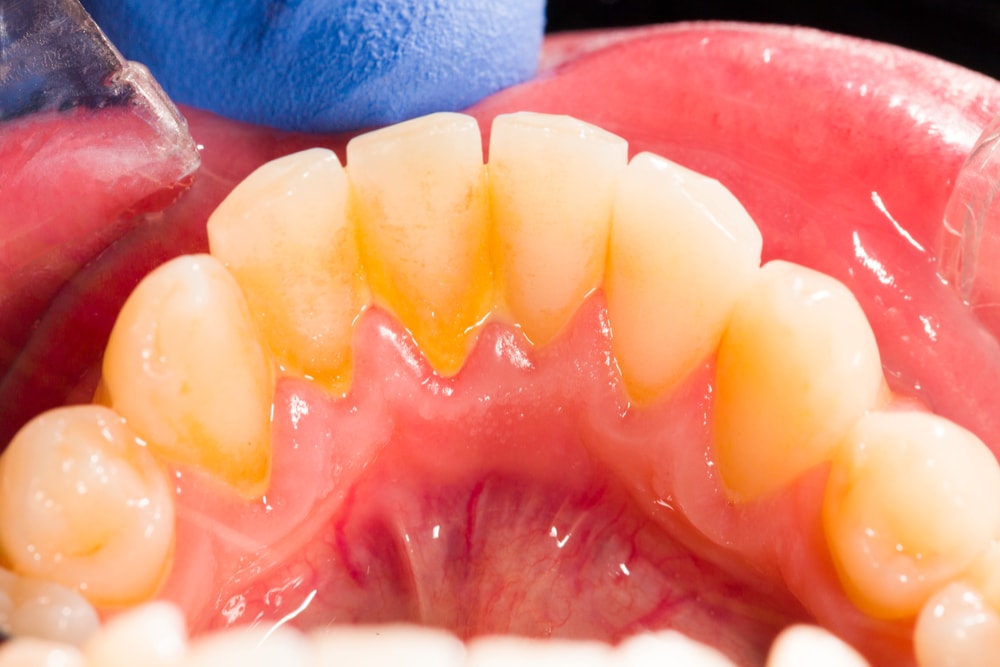
Some causes of extrinsic discoloration include:
- Ingestion of certain colored foods and drinks.
- Use of tobacco.
- Use of topical medications like an antiseptic mouthwash. These may combine with tannins (naturally occurring substances) found in tea, wine, … and stain your teeth.
- Plaque and calculus. Calculus is mainly found around the gumline.
Intrinsic discoloration instead involves the internal structure of the tooth (or of all the teeth). Some causes include :
- Use of antibiotics for the treatment of acne, like tetracycline.
- Tooth decay (dental caries).
- Dental trauma.
- Fluorosis which results from excessive ingestion of fluoride during enamel formation.
All this is intriguing and leads to the next question …
How can teeth change color over time, and sometimes also quite quickly?
For that, we need to understand stains.
How do teeth turn yellow or even dark?
Your teeth may change from white to a less bright, dull color as a result of many causes.
Yes, there is not just one culprit but many.
So, let’s look at these factors.
Ready to go?
Buckle-up, because the list is long:
1. Natural aging, because of your brushing. Your enamel will wear out, get thinner and darken over time. Yellowish dentin will thus show through.
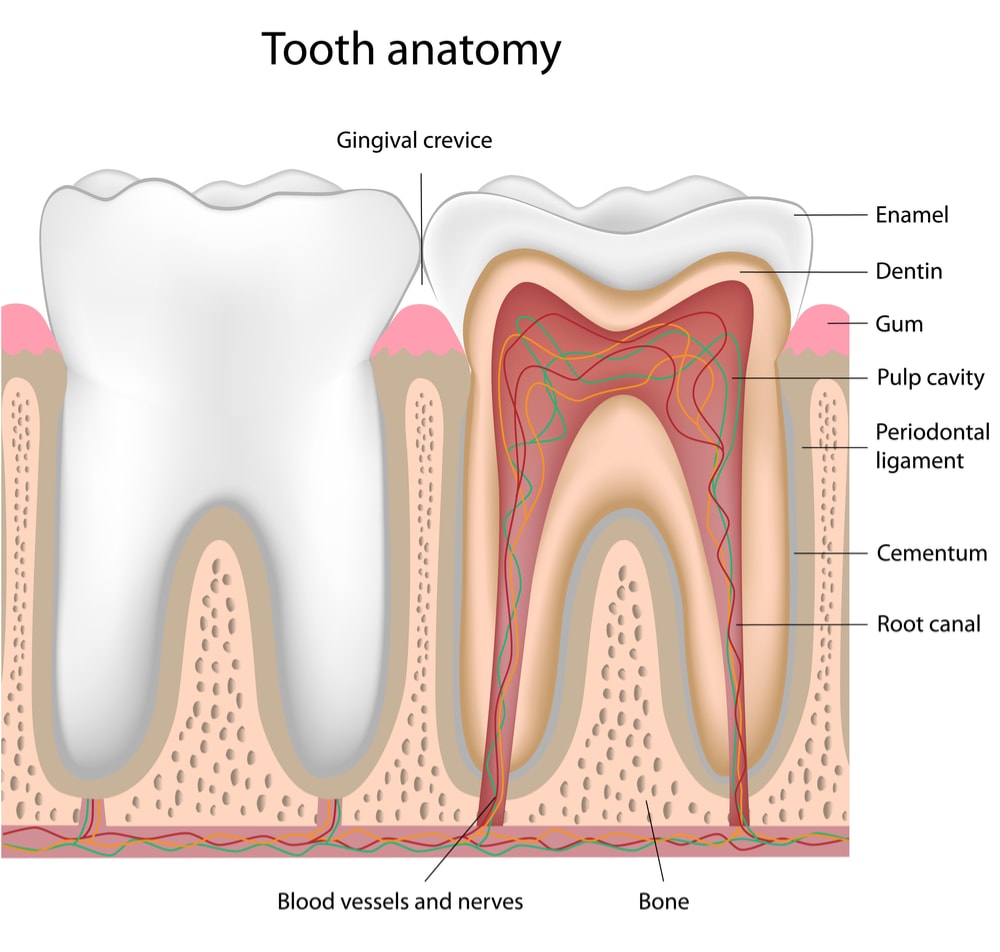
2. Plaque and tartar build up. They cause your teeth to look yellow.
They get stained if you:
- Smoke on a regular basis.
- Drink coffee, tea, or red wine (also on a regular basis)
- Consume drinks and foods containing pigments (see also Food, drinks and teeth whitening results).
- These coloring agents impact your teeth over time by attaching to your enamel (more explanations about this later).
- Some foods and beverages containing pigments include:
- dark sodas
- coffee
- wine
- fruit juices
- and tea.
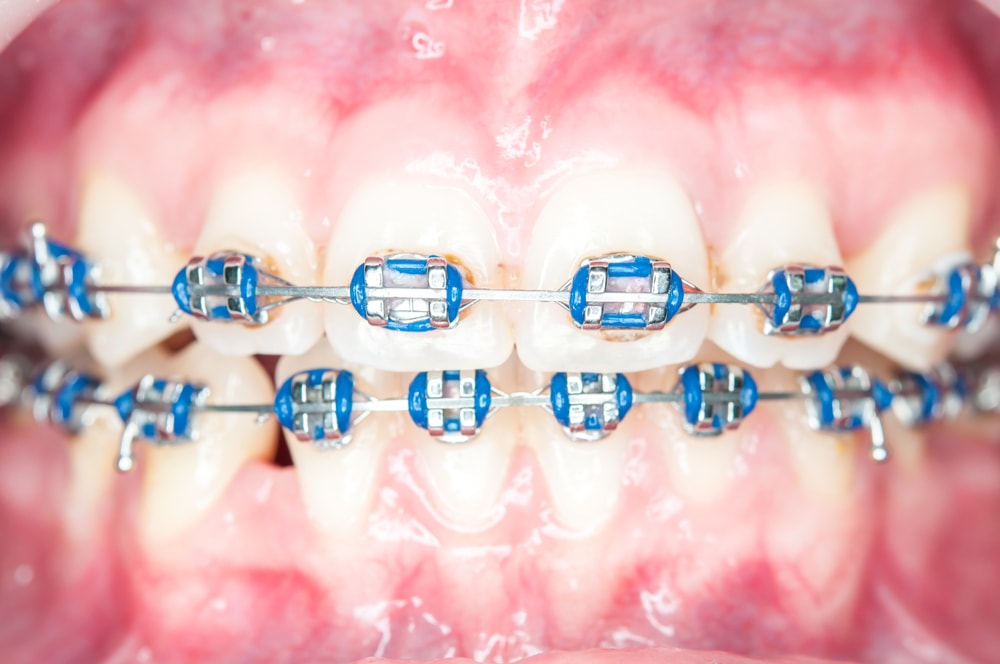
3. Orthodontic treatments:
- tend to discolor or stain teeth over time.
- The metal brackets and wires used in these procedures trap bacteria and food.
- This is also true, albeit to a lesser degree, if you choose Invisalign® instead of traditional braces.
4. Trauma, such as when you receive a blow or suffer from a fall. These events may stain or discolor your teeth. The darkening results from the production of dentin. If this incident happened during your childhood, the change in structure could show later in adulthood.
5. Whitening is not as effective in such situations because discoloration comes from deep within the teeth. Sometimes teeth look yellow because the outer hard enamel has never grown. Your enamel’s lack of growth could be due to genetic malformations or trauma suffered during childhood. The darker, naturally yellower dentin is thus exposed.
6. Exposure to tetracycline and doxycycline (antibiotics) may interfere with your teeth formation.
- This phenomenon happens either as a baby or when in the womb.
- Teeth discoloration can then show later during your adulthood. It will reflect the darkening or yellowing of dentin in the inner layers of your teeth.
- For these types of cases, whitening treatments tend to be less effective.
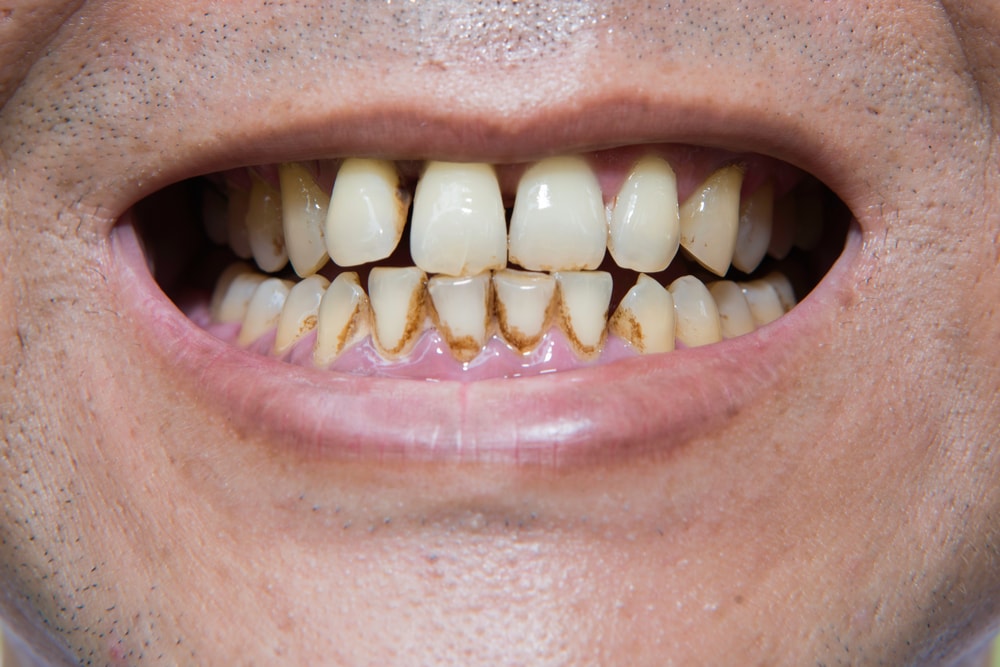
7. Tobacco use can lead to stubborn stains. These result from smoking cigarettes, pipes, cigars or even chewing tobacco (more on this later).
8. Excessive absorption of fluoride compounds during enamel formation.
- It may lead to staining or darkening of teeth (fluorosis).
- Fluoride has benefits in helping to prevent cavity formation. Hence, it is often present in drinking water. Yet, an excess of fluoride intake may result from:
- abundant consumption of fluoridated tap water;
- ingestion of fluoride toothpaste;
- mouth rinses (which children tend to ingest).
Phew, that was long!
We said above that we would later explain how enamel gets stained from pigments and tobacco.
Now is later, so check the next section.
How do teeth get stained from colored food and tobacco?
When you look at your teeth’s enamel surface with a naked eye, it looks very compact, doesn’t it?
But if you move to a microscopic level, you will discover that it is porous. Tiny organic particles can thus penetrate the pores and remain attached.
And a higher porosity will lead to more persistent stains. Hence, your teeth turn purple and may stay purple when you eat blueberries if your teeth’s porosity is significant.
By now, you may be wondering whether porosity can change (?) and what you can do to protect your teeth.
The answer to the first question is that it can indeed. For instance, it will increase after contact with acidic substances. These demineralize enamel’s crystals making it easier to penetrate it.
So, any substance whose fermentation produces acids will affect the porosity.
Good dental hygiene will, therefore, go a long way in protecting your enamel’s porosity.
As for tobacco, its stains result from two chemical compounds:
- nicotine which is colorless but gives teeth a yellowish color in the presence of oxygen,
- tar which instead is naturally dark
Now, I guess we all know how to avoid staining from tobacco.
But how does one reduce staining from foods? I mean, you can quit smoking, but drinking and eating is not an option, right?
Continue reading to discover the answer.
How do you prevent teeth staining from foods’ pigments?
We have seen that the consumption of certain colored drinks and foods can affect the color of your pearly whites.
Now, it is possible to reduce this by changing your habits somewhat:
- Decreasing (or avoiding) the consumption foods and drinks that darken your teeth.
- Rinsing and brushing your choppers after consumption (of such foods or drinks).
- Using a straw to avoid direct contact with staining drinks, such as wine, coffee, or tea.
Let’s now look at how well in-office dental whitening works for different types of stains.
Which stains does in-office dental whitening remove?
The answer to this question is well-known.
Good candidates for in-office teeth whitening are those with stains that have accumulated from:
- dark soda,
- sauces,
- fruits, in particular berries,
- coffee,
- red wine,
- fruit juices,
- colored foods,
- tea,
- antibiotic tetracycline stains.
Now, before we study more closely the different methods available to improve your smile, let me ask you a question…
Do you know which compounds are at the heart of most teeth whitening methods?
If you do not, check the next section, because it will be useful to understand this guide better.
The compounds we will discuss are at the heart of many teeth whitening products.
Hydrogen peroxide and carbamide peroxide
How are carbamide peroxide and hydrogen peroxide used in dentistry?
So, as you have surmised already from the title …
… the compounds that are responsible for improving the appearance of your teeth are:
- carbamide peroxide
- hydrogen peroxide
You may have childhood memories of getting scraped or cut and then cleaning the wound with a liquid from a brown plastic bottle.
The magical bubbling, fizzy, and crackly sound, that you have most probably witnessed, is due to hydrogen peroxide.
Its chemical formula is:

When it comes into contact with your tissues, moisture or chemicals (e.g., pigments) on your teeth, it breaks down into water and oxygen. Hence the fizzy sound.
It releases oxygen in a burst. And oxygen is what makes it a powerful cleaner.
And what about carbamide peroxide?
“Carbamide peroxide decomposes to release hydrogen peroxide in an aqueous medium (10% carbamide peroxide yields roughly 3.5% hydrogen peroxide)”1 along with urea.
So carbamide peroxide is nothing other than an alternative source of hydrogen peroxide.
Reason why some whitening products contain carbamide peroxide, while others use hydrogen peroxide instead.
You will find them both as active ingredients in tooth whitening products used in dental offices.
Most OTC bleaching products instead are hydrogen peroxide-based, although some contain carbamide peroxide.2
The concentrations used in a dental office will be high, in the order of 15–38% of hydrogen peroxide (or an equivalent level of carbamide).
But these products will be used for shorter time periods.
Otherwise, when lower concentrations are present (3%-10%), you will find them:
- In oral hygiene products. These include toothpaste and mouth rinses. Their disinfecting action will help prevent plaque formation and inflammation of your gums.
- Mass market products, or OTC teeth whitening products.
Differences between carbamide peroxide and hydrogen peroxide
As we have seen above, both are bleaching agents.
Because of their “bleaching nature,” they do not just remove surface stains (like non-bleaching agents).
Instead, they penetrate the enamel, exfoliate or break stains up and eliminate them.
So, they also clean deep (intrinsic) stains and can thus bring your teeth back to their natural color.
As we have explained, it is the oxygen molecules within the whitening agents that decompose the pigments.
But there may be some differences, between carbamide peroxide and hydrogen peroxide, in terms of:
- efficacy,
- sensitivity, …
Don’t you think?
Actually not, at least according to a study by the Journal of the ADA.
Provided resulting concentrations of hydrogen peroxide were equal:
- both produced important results;
- were equally effective at removing deep stains (intrinsic) as well as surface (extrinsic) stains;
- did not show any significant differences in teeth sensitivity.
The only difference is that hydrogen peroxide is faster. Its bleaching effect will occur within 30-60 minutes.
Carbamide instead will break down your stains more slowly. It will release 50% of its whitening effect within 2 hours of its application. Its activity may continue for up to 6 hours afterwards.
Another difference is that carbamide peroxide has a slightly longer shelf life than hydrogen peroxide. This difference disappears when both are refrigerated.
In-office teeth whitening procedures make use of gels containing either carbamide peroxide or hydrogen peroxide.
Final remarks
I hope you have enjoyed this first article.
Its goal was to serve as an introduction to the world of teeth whitening.
Now, if you are looking for professional teeth whitening in NYC then check in-office teeth whitening in NYC at 10022 or book an appointment with us.
If, instead, you wish to become a teeth-whitening erudite 
It will take you by the hand and show you how in-office teeth whitening procedures work.
After that, also take a peek at the remaining chapters:
- Chapter 2: Whitening strips, toothpaste, paint-on films, and trays with gels
- Chapter 3: Teeth whitening results
- Chapter 4: Sensitivity and gums’ irritation after teeth whitening
- Chapter 5: natural methods to preserve or whiten your teeth
Let us know in the comments if you have any questions.
See you soon!
SUTTON PLACE DENTAL ASSOCIATES ON THE WEB







